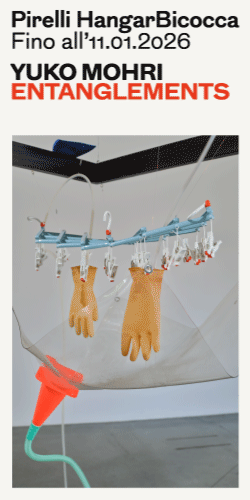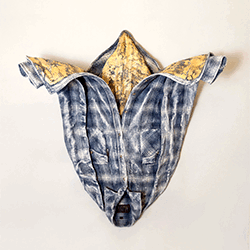[nemus_slider id=”42380″]
On April 8 inaugurated The Mortician’s Athlete and the Dreaded Barista, solo show by Nicholas Cheveldave curated by EMALIN (Leopold Thun and Jasmine Picot-Chapman). The artist’s new body of work takes as its point of departure aspects of contemporary “café culture” and blends it with various forms of mundane life.
Matteo Mottin in conversation with Nicholas Cheveldave.
Matteo Mottin: Can you introduce me to your artworks? In all of them we see in the background an organ of the body and bar items in the foreground,
Nicholas Cheveldave: The body organ in the background is spray painted, on top of it I put a 3D print with bar items. Everything around the organ is white, and the 3D print is clear plastic, so the canvas itself is lighting the print, everything is activated by the painting underneath. What surround them is a kind of objects obtained with a 3D rendering program, like coffee cups and vessels. It’s about an object that becomes bodily, and the flow is kinda like a figure through the space. And there is also photos of fetishized objects within the barista culture. It’s basically about choosing something. Before was golf, now we have the barista, afterwards I’ll probably do another one. But this is about this kind of sub-genre I’m not exactly part of, and I don’t understand properly, but it’s about taking images from that culture and use them. I wouldn’t say it’s abuse, it’s just taking things without properly understanding them. Images like that are all over social media quite often.
MM: The paintings in the show are displayed in a wide, well illuminated open space, then there is a small, darkened room. Is it dark because the inside of our bodies is also dark?
NC: Exactly. It’s basically really white, really perfect objects, and then there’s this other side, dark, grim and dirty. That’s the actual physical representation of it. There’s also a cup, which has the same geometry of the cup printed on the paintings, and I had it 3D printed, so it’s physically present as a piece along with the dirty things we got on the inside. You never think about your liver until you drink so many beers and you’re like “oh my God”. And there’s also the idea of the Mortician’s Athlete, a really great 1918 pre-dada poem by Francis Picabia. I love the flow of it. It’s linear and makes sense, but at the same time it jumped around and talks about incredible things. It even references coffee. At the center of this room there’s a quite hard and solid object. It’s made of plaster and I spray-painted it.
MM: Which kind of body part is it?
NC: It’s nothing. It’s kind of an amorphous. It’s like the organs, with their references to the body, but it’s not specific. It doesn’t have a face, it doesn’t have hands, it doesn’t have genitals, it’s not male or female, it’s very androgynous.
MM: What about the dreads on the sculpture?
NC: They’re made out of wool. They’re felt. They were made by this person called The Traveling Pixie, in the North of England. (laughs) They’re fantastic, they’re really nice quality. It’s related to something that could be seen as Post-shamanism, or Anti-shamanism. A shaman is someone who learns so much about something and tries to become it, to understand it. But now I think a lot of times people would try to change something to suit that. So it’s like taking things and making them yours, opposed to taking time to understand something, and understanding the wholeness of it. It’s like doing not enough research.
MM: That’s the reason of the posters and the altar in the room.
NC: Yes. It’s also fetishization. The fetish of the cup, the object, the tactility, the touch. And also when you walk in the room you can feel something crunchy beneath your feet. It’s trying to make an atmosphere on you, really. But it works more or less like an archive.
MM: So, this is a series of paintings about the body parts, in particular about the organs, and you’re making a connection between what’s outside of the body that has to go on the inside. You’re also making a comparison between shamanism and new age culture, as something that’s both on the outside and on the inside of the body. What kind of experiences led you to make this exhibition?
NC: A lot of it I think it’s being, and being part of it as well. I don’t think this is irony or anything like that. It surrounds me, and I’m part of it, and this is my own way of digesting it and try to figure out how I fit into this place or how I can understand a little bit more through this. Taking images of these things that exist around me and filtering them out by putting them through my own body, trying to categorize a little bit for myself. I finished my studies and Goldsmiths, and I studied with Mark Leckey. He talks a lot about this idea of mediation. To really understand something you have to look at it so much and distance yourself, and try to look at yourself through reflection. I just thought that it was so true. You know, you can never step back and look at yourself unless you put yourself out there enough to look at you. So I was trying to do that, and put my art out there was kinda a little intense and a little too much. And I was kinda, “let’s see how it goes”, because I didn’t know how this would turn out until I made it.
MM: And you’re doing this with something very common, like a cup of coffee.
NC: I like the pop culture references as well. I think there’s no longer an outside artist, or outside culture, because with the availability of the informations on the internet something always comes to light. 50 years ago it would take 20 years to something to come in the culture, but as soon as it’s on the internet many people see it and it becomes a meme, it becomes a pop cultures of themes, and people blend it. So, in that regard, I thought that using things that were very mundane, regular, everyday things, would become the best way opposed to try to find something that was the next weirdest, strangest thing.











